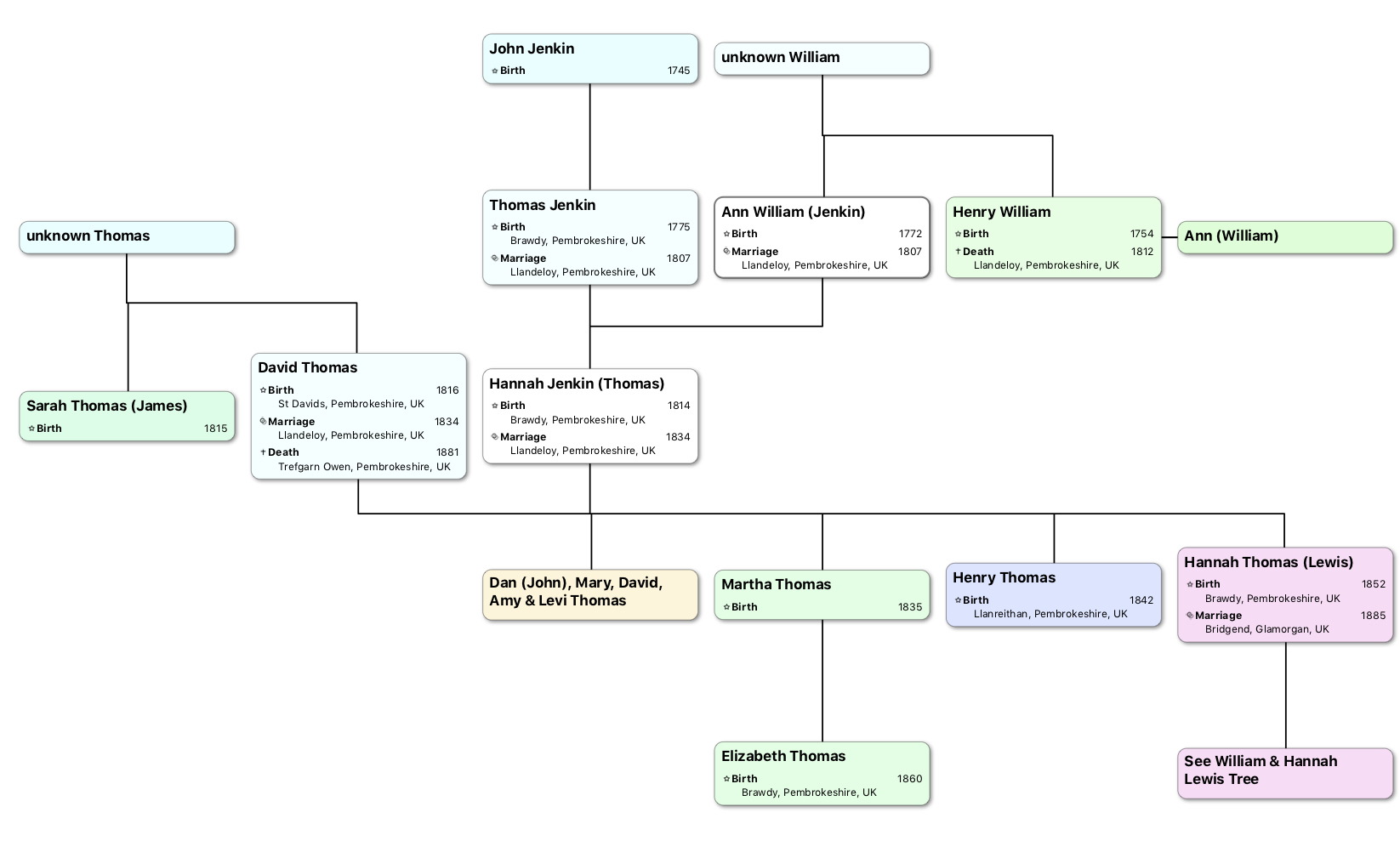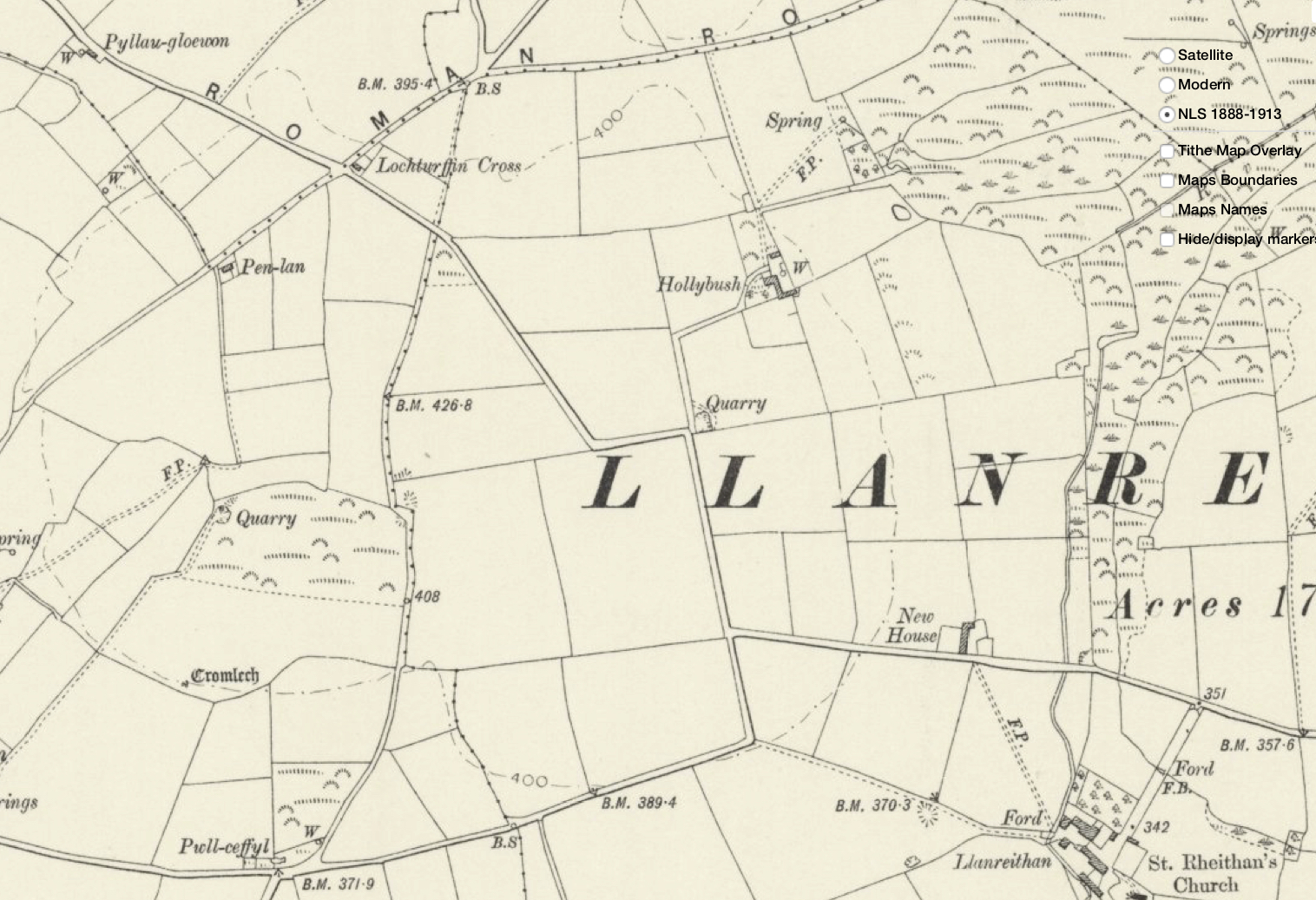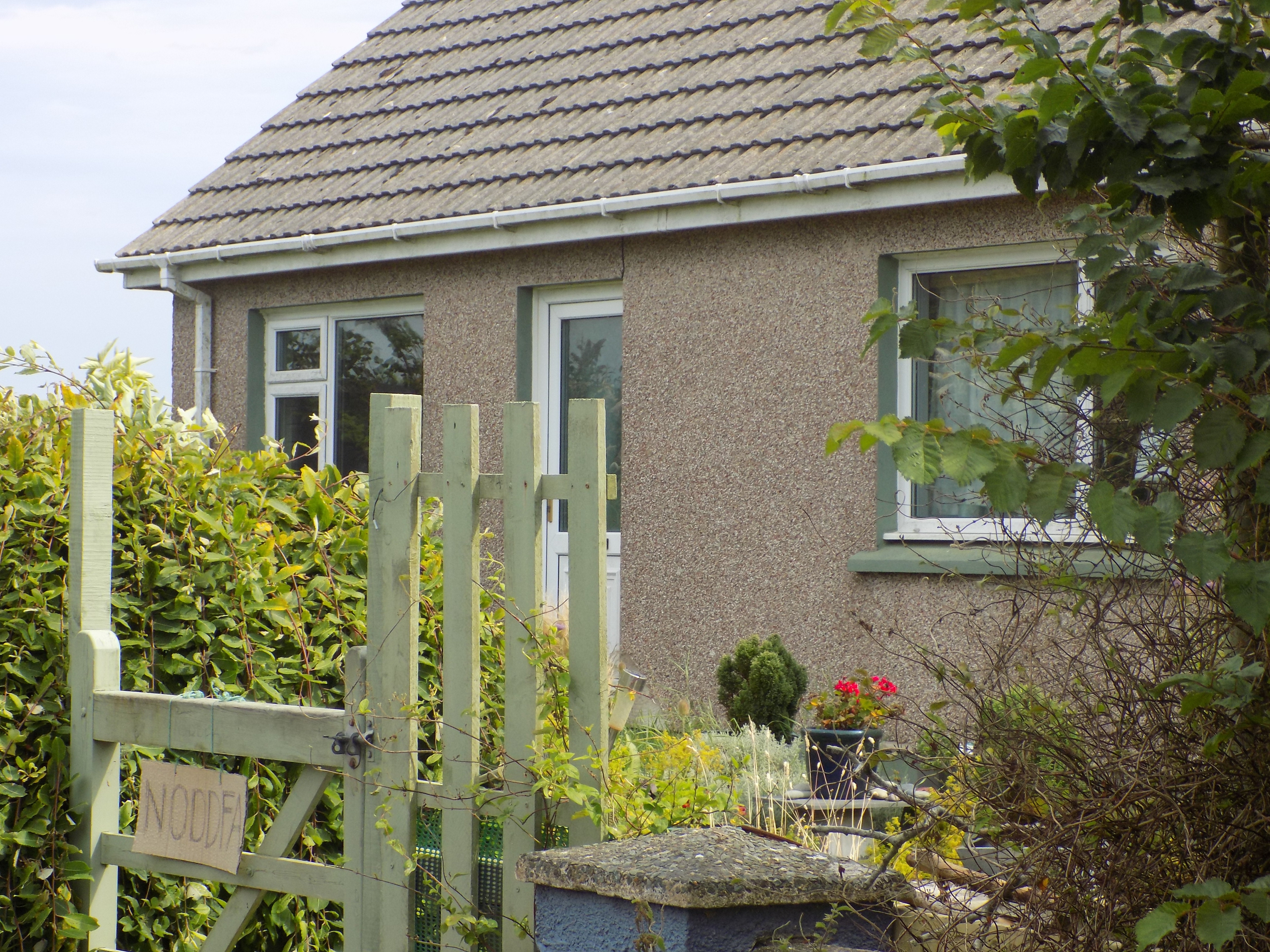8. Thomas & Jenkin Families, Pembrokeshire

Thomas and Anne Jenkin lived in Llanreithan, Pembrokeshire – which comprised a small hamlet plus outlying farms. Their daughter, Hannah married David Thomas (who was born in St Davids), and they lived as farm labourers in the area. They had many children, but some died young, and those that survived were working as farm servants at a young age. The relationship with other families is that Hannah and David Thomas’ daughter - Hannah Thomas - moved to Bridgend, Glamorgan and married William Lewis, and was mother to Sarah Williams.

David (1816 - 1881) & Hannah (1814 - , born Jenkin) Thomas
David Thomas was born around 1816 in St Davids, Pembrokeshire and was a farm labourer.
Hannah Jenkin was born 1814 to Thomas and Anne Jenkin at Llanreithan, Pembrokeshire.
1834 Sep. Marriage of David Thomas and Hannah Jenkins, by vicar of Llandeloy, Pembrokeshire. In presence of Thomas Jenkin (Hannah’s father)
1841 census - “Pollygloivon, Llanrithan”, Pembrokeshire
- David Thomas born Pembrokeshire, age 25-29.
- Hannah Thomas born Pembrokeshire age 25-29.
- 3 children - Martha Thomas (b.1835), Dan Thomas (b.1838) & Mary Thomas (b.1840)
- Abode shared with Thomas Thomas (age 35) and Amy Thomas (age 34)
1842 baptism certificate for a David Thomas born to David and Hannah Thomas in 1842 in Llanreithan
1851 census - “Pillegloivon, Llanrithan”, Pembrokeshire
- David Thomas was born St Davids, age 42 (ie b. 1809)
- Hannah was born “Llanwnda”, Pembrokeshire (and though stated birthdate is around 1799 - this is certainly a mistake and indeed in the original census document it is difficult to decipher her age).
- With John Thomas age 12, born Llanrithan (who presumably is the same person as Dan Thomas age 3 of the 1841 census)
- They share a house with family Nicholas.
The residence “Pillegloivon” or “Pollygloivon” is 2 adjoined cottages identified on the map below (called Pyllau-gloevon). The Genuki Place name database for Pembrokeshire also references a ‘Pyllegloywan” in Llanreithan, which provides a grid references to these same buildings. A tithe map for the Parish of Llanvithain in the County of Pembroke, 1839 (source NLW) lists “Pwllagloyfon” field – which is across the road from these 2 cottages. These are part of ‘Llochlurfin farm’, owned at this time by a Dorothy Davies. These cottages still exist, though it is now one residence, on the B4330, just North West of Llanreithan House (at -51.921916, -5.124035).
1853 September Birth certificate (ref: 11A, 569, 82 – obtained) for Amy Thomas born to David and Hannah Thomas. Hannah’s maiden name given as “Jenkin”. David Thomas is labourer. Address is “Pant y cadno”, Brawdy.
1861 census - “Orsedyrhyw”, Brawdy, Pembrokeshire
- Orsedyrhyw street is located in Llanreithan and includes the residences of 4 families.
- David is an agricultural labourer, born 1814 in St Davids, Pembrokeshire, Hannah born 1811, Brawdy, Pembrokeshire.
- With children: Martha (b.1836 Llandeloy)
- Levi (b.1848 Llandeloy)
- Hannah (b. 1852 Brawdy) (who went on to marry William Lewis)
- Amy (b.1854 Brawdy)
- John (b.1856 Brawdy)
- plus Granddaughter Eliza Thomas (b.1860 Brawdy and presumably daughter of Martha Thomas – age 25 at this time).
1871 census - “Noddfa”, Llandeloy, Brawdy, Pembrokeshire
- Hannah Thomas is farmers wife (age 60, b. 1811) born Brawdy. Implies head of household is away.
- With Elizabeth Thomas – granddaughter age 11 (b. 1860, Brawdy).
- “Noddfa” is a bungalow in Llandeloy – meaning ‘Refuge’ in welsh. A cottage called “Noddfa” still exists today near Llandeloy - location 51.893970, -5.099381 – see picture:
1871 census. A strong possibility for where David Thomas is in 1871 is that he is visiting, and probably working for, his sister. 1841 – 1881 censuses show a Peter James, stonemason and wife Sarah James (b. 1813 - 1819) living in Telegraph House, Hubberston, Pembrokeshire together with various children. In 1871 they are joined by a David Thomas, brother-in-law (b.1811) and Henry Thomas, nephew (b. 1842).
- This implies Sarah James was born Sarah Thomas, and there is evidence of a Sarah Thomas b. 1815 at Rhodiad and Ebenezer chapel, St Davids to a William and Mary Thomas. David Thomas, her brother, also comes from St Davids (but no birth/ baptism certificate).
1881 census - "Foxen", Brawdy, Pembrokeshire
- David Thomas is widower and farm labourer, age 66 (b. 1815) living in Brawdy. Birthplace is Pembrokeshire.
- Abode is given as “Foxen” which according to Genuki Place Name database for Pembrokeshire is just south of Trefgarn Owen (location 51.879373, -5.099665). Google Maps shows there is no longer a building at this point – just a strip of woodland.
1881 Administration of the personal estate (worth £60) of David Thomas, late of Foxen, in the Parish of Brawdy in the County of Pembroke. Widower who died Sept. 1881 at Foxen was granted to Henry Thomas of Treffgarne, Brawdy, Mariner the son and one of the next of kin. (Source: Will and Probate Records, NA).
Thomas (1775 - ) & Anne (1772, born William) Jenkin
Thomas Jenkin was born 1775 to Henry and Mary Jenkin at Llandeloy, Pembrokeshire. Note Jenkin is also spelt Jenkins in some documents.
Anne William was born 1772.
1807 Marriage of Thomas Jenkins (widower) of Llanreithan to Anne Williams of Llandeloy, Pembrokeshire. At Llandeloy church by vicar of Llandeloy. In presence of Henry Williams (presumably Anne’s brother).
1807 Marriage Settlement. Settlement (essentially a pre-nup) for Thomas Jenkin and Ann William which transfers both of their household goods and possessions to trustees (File 64, part of PV Davies Collection of Pembrokeshire Deeds, NLW). Parties: Thomas Jenkin of New Inn in the Parish of Llanrithan, Yeoman; Ann William of Finnon Wen in the Parish of Llandeloy, spinster; Henry William of Little Mill in the parish of Llandeloy, miller; and John Jenkin of Blaen Wain in the parish of Mathry, yeoman. The purpose of this settlement appears to be to protect the rights of William Jenkin, the son of Thomas Jenkin by his former wife, and possibly also protect these assets from his former wife.
Henry William (1754 – 1812), miller of Llandeloy, appears to be the brother of Ann Williams (Jenkin):
- 1784 (Possible) Marriage Banns for Henry William and Ann David, in Llandeloy, Pembrokeshire.
- 1812 death certificate for Henry William, estimated born 1754 and died June 1812 (Pembrokeshire Parish registers).
- 1812 Will for Henry William, miller (source NLW) states:
- Living ”Velinvach” in Parish of Llandeloy
- Leaves sister Mary Phillips 1 shilling
- Leaves sister Ann Williams 1 shilling
- Leaves wife Ann Williams all stock, crops, furniture etc
1814 baptism of Hannah Jenkin to Thomas and Anne Jenkin at Llanreithan, Pembrokeshire.
Llanreithan, Llandeloy and Trefgarn-Owen
Llanreithan (or Llanrithan or Llanrythan) comprises a wide area of farmland plus a small hamlet and church in Pembrokeshire (location 51.913298, -5.106427). It is just north of Llandeloy and Trefgarn-Owen. Llanreithan comprised around 35 properties (including outlying farms) in the 1850’s, but by 2011 comprised only 9 properties. The hamlet formerly comprised a walled garden with a manor house, which fell down around 1830 (apparently it was the last place in the UK to employ a full time jester). Llanreithan house, a farmhouse, was subsequently built on adjoining land. Lanreithan church is adjacent. Map shows Pyllau-gloevon houses (top left) and Llanreithan House and church (bottom right) (1880-1913 map reproduced with the permission of the National Library of Scotland – website https://maps.nls.uk/index.html)

Llanreithan church lies disused and abandoned in its churchyard adjoining Llanreithan House, all trace of its medieval origins were lost in a Victorian restoration (1862). A foundation stone dated 1493 that was discovered during the rebuilding has subsequently vanished too and all that remains from earlier times is a cross-shaped stone set in the altar. The interior of the building is in a very dilapidated state and the damp is making rapid inroads (2007 survey in Geograph). By 2019 it is a privately owned residence (see picture below).
Llanreithan parish was merged with Llanrhian in 1877 and then in 1906 disunited and united instead with Llandeloy (Church of St Teilo & St Rheithan), though the parish is often classified within the wider Brawdy (“Breudeth” in welsh) Parish, which is a small village further to the South-West.
Llandeloy church was also in disrepair - "The roof of the Church which has for a long time been in a state of dilapidation now fallen in" (Religious census of 1851). Rebuilt 1925-26.

